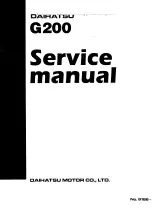
WWW.MANUALS.WS
WWW.MANUALS.WS
113
TANDEM MASTER CYLINDER BRAKE
SYSTEM
The tandem master cylinder brake sys-
tem is a hydraulic system with two sepa-
rate sub-systems. If either sub-system
should fail, the other will still work. Howev-
er, the pedal will be harder to press, and
your stopping distance will be longer.
Also, the brake system warning light may
come on.
CAUTION
!
Do not drive your vehicle with only
a single brake system. Have your
brakes fixed immediately.
BRAKE BOOSTER
The brake booster uses engine vacuum to
power-assist the brakes. If the engine
should quit while you are driving, you can
bring the vehicle to a stop with normal
pedal pressure. There is enough reserve
vacuum for one or two stops—but no
more!
CAUTION
!
Do not pump the brake pedal if the
engine stalls. Each push on the
pedal uses up your vacuum re-
serve.
Even if the power assist is com-
pletely lost, the brakes will still
work. But you will have to push
the pedal hard—much harder
than normal. And your braking
distance will be longer.
ANTI-LOCK BRAKE SYSTEM
(with “ABS” warning light)
The anti-lock brake system is designed to
automatically help prevent lock-up of the
wheels during sudden braking or braking
on slippery road surfaces. This assists in
providing directional stability and steering
performance of the vehicle under these
circumstances.
The anti-lock brake system becomes op-
erative after the vehicle has accelerated
to a speed in excess of approximately 10
km/h (6 mph). It stops operating when the
vehicle decelerates to a speed below
approximately 5 km/h (3 mph).
You may hear a sound in the engine
compartment for a few seconds when the
engine is started or just after the vehicle
is started. This means that the anti-lock
brake system is in the self check mode,
and does not indicate a malfunction.
Effective way to press the “ABS” brake
pedal: When the anti-lock brake system
function is in action, you may feel the
brake pedal pulsating and hear a noise.
In this situation, to let the anti-lock brake
system work for you, just hold the brake
pedal down more firmly. Do not pump
the brake. This will result in reduced
braking performance.
The brake pedal pulsation caused by the
anti-lock brake system may indicate haz-
ardous road surface conditions. Although
the anti-lock brake system assists in pro-
viding vehicle control, it is still important to
drive with all due care, because the anti-
lock brake system cannot overcome the
laws of physics that act on your vehicle:
Braking capability is dependent on tire
friction with the road surface.
Brake system
















































